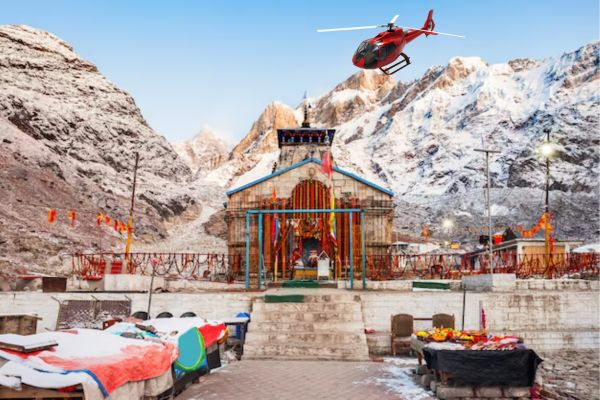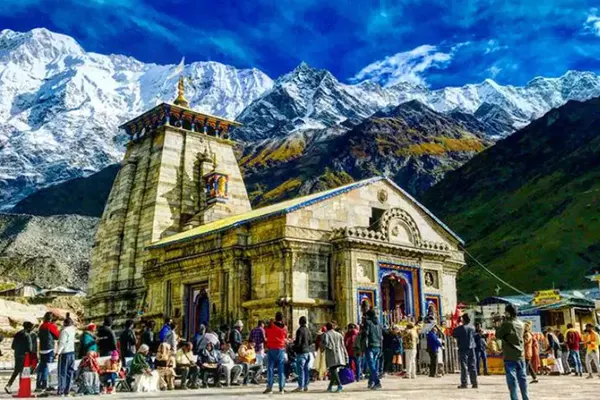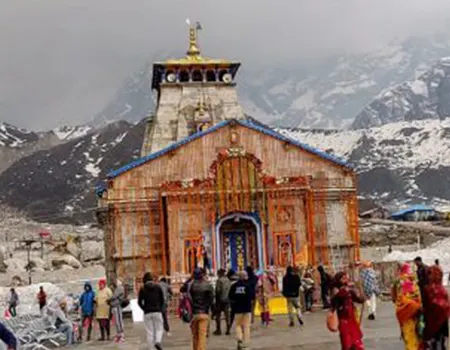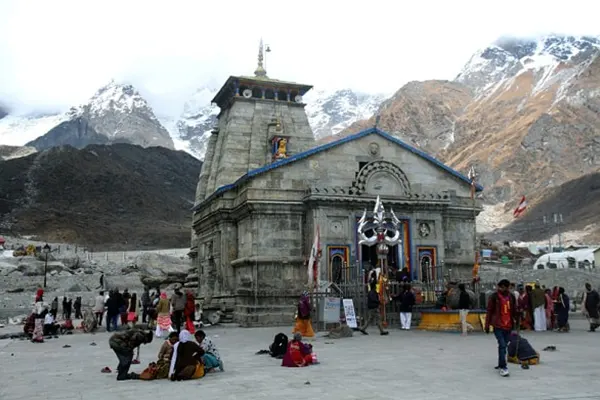Kedarnath, Uttarakhand – The sacred gates of the Kedarnath Temple, one of the most visited Char Dham shrines in India, are all set to open on 2 May 2025, bringing a wave of spiritual energy back to the Garhwal Himalayas. After months of anticipation and countless prayers, the Kedarnath opening date has finally been announced and for lakhs of devotees across the country, this isn’t just news, it’s an emotion. You can visit Kedarnath ji Temple on our Chardham Yatra by Helicopter.
As per tradition and temple trust officials, the Kedarnath Temple will open on the holy occasion of Akshaya Tritiya. On this day, priests reopen the sanctum after a six-month winter closure, and the entire valley echoes with chants of “Har Har Mahadev.” From locals to yatris, everyone waits for this day like a festival.
But this spiritual season is short-lived. Just as the opening marks a new beginning, the Kedarnath closing date is just as important because once the cold sets in, the temple shuts its doors again. This year, the Kedarnath temple closing date is not yet declared. Once it is confirmed the idol of Lord Shiva is taken to Ukhimath, where prayers continue through winter.
So if you’re planning to visit Kedarnath in 2025 this is the time to act. The pilgrimage window is limited. Whether you’re booking your stay, finalising your yatra registration, or securing your helicopter slot, planning around the Kedarnath opening date dates is key. Missing the timeline means waiting another year.
In this special coverage, we’re not just giving you dates, we’re giving you everything: how the Kedarnath opening dates and Kedarnath closing date are decided, what happens during the ceremonies, where the idol goes in winter, and how to make sure your trip goes smoothly.
When Does Kedarnath Temple Open and Close in 2025

People wait the whole year just to know – “Kedarnath kab khulega”? That’s the main thing. Because this temple doesn’t stay open all the time. It opens once the snow melts. And closes again before winter hits hard. In 2025, the Kedarnath opening date is 2 May. That’s also called Akshaya Tritiya, which is considered a very lucky day in Hindu tradition. Every year, this same tithi is followed for opening. It’s not decided randomly. Proper rituals are done, and then only they fix the date.
Now talking about the Kedarnath closing date that is not yet declared, it will be declared by a community member of the temple around Navratri. That’s when the gates shut for the season. After that, Kedarnath gets covered with snow. Nobody can go there. Not even the locals.
Here’s a short chart if you want to keep a note:
| Kedarnath Opens | 2 May 2025 |
| Kedarnath Closes | Not yet Declared |
These kedarnath opening date and kedarnath closing date, are not just any dates. They’re official, declared by the temple committee and local priests. They do proper calculations using Panchang and jyotish vidhi. Many people try to go on the first day itself. The crowd was too much then. Some go during the last week just to attend the closing ceremony.
If someone wants less rush, they should aim for September or early October. But even in May, the trek can still be slippery or frozen in patches. Snow doesn’t go away overnight. So, it’s better to go prepared. Weather up there changes without warning.
How Are Kedarnath Temple Opening and Closing Dates Decided Every Year

The dates for Kedarnath opening date and Kedarnath closing date are not fixed from before. They change every year. But they’re not picked randomly either. There’s a full tradition behind it, followed for generations.
The temple opens on Akshaya Tritiya, but the exact kedarnath opening date is decided on Maha Shivratri about two months earlier. The priests of Omkareshwar Temple in Ukhimath sit together, check the Hindu Panchang, and decide the muhurat. The Badrinath-Kedarnath Temple Committee (BKTC) made it official after that.
It’s not just math or astrology. The date also depends on weather conditions and whether the snow on the path has started melting or not. Because if the trek is blocked, the temple might be open, but no one can reach.
Once the kedarnath opening date is decided, the idol of Lord Kedarnath is moved from Ukhimath to Kedarnath in a doli yatra. It’s a proper procession. Stops at different places along the way. Locals gather. Bhajans are sung. And finally, the idol reaches the main temple before the gates open.
So to sum it up:
- Opening date = Decided on Maha Shivratri, based on Akshaya Tritiya tithi
- Closing date = decide around Navratri
- Everything is based on Hindu calendar + weather + rituals
It’s not just a schedule. It’s a mix of faith, tradition, and nature. That’s why people trust the Kedarnath opening dates completely and plan their whole yatra around them.
What Happens During Kedarnath Temple Opening Ceremony

The opening day at Kedarnath is not just a temple event, it feels like a full celebration in the mountains. Anyone who’s ever seen it knows it’s something you don’t forget easily. It all starts with the idol of Baba Kedarnath, which stays in Omkareshwar Temple in Ukhimath during winter. Around 8–9 days before the kedarnath opening date, the idol is taken out with full rituals.
This is not just done silently. There’s a proper doli yatra – with bells, bhajans, drums, and villagers walking alongside. This holy journey passes through places like Guptkashi, Phata, and Gaurikund, and finally reaches the main Kedarnath temple. Locals and pilgrims wait on the way just to get one glimpse of the doli.
On the day of the opening, this year it’s 2 May 2025, the temple is decorated fully. Flowers, fresh paint, everything. People gather as early as 3 or 4 in the morning. You’ll see people wrapped in blankets, waiting in line quietly. There’s a sense of peace and power in the air.
Around dawn, priests start the Maha Abhishek. Only after that, the doors are opened. There’s no shouting or rushing inside. Everyone enters slowly, hands folded, eyes full of devotion. Most people get emotional. After all, Baba Kedarnath is being welcomed back after six long months.
Some important things that happen on opening day:
- Special pujas for the first darshan
- Aarti and chants led by head priests
- Arrival of BKTC officials and local leaders
- Tight security and crowd management
- Limited entry due to high rush
- Weather updates are closely watched
Those who want to attend this should reach Kedarnath or nearby places like Sonprayag or Gaurikund at least 2–3 days early. Roads get crowded, hotels fill up, and trekking gets slower due to footfall. So yes, the opening ceremony is not just about opening doors. It’s about welcoming Lord Shiva back to his Himalayan home. It’s about starting another season of blessings, prayers, and faith.
What Happens During Kedarnath Temple Closing Ceremony

The closing ceremony at Kedarnath Temple is not just a goodbye to a holy place, it’s a moment filled with deep emotion. Locals believe that after this kedarnath closing date, Lord Shiva leaves Kedarnath and shifts to Omkareshwar Temple in Ukhimath for the winter months. So, for many people, this day feels like a farewell to their beloved god.
What Really Happens on This Day?
Everything starts early in the morning. Unlike the bright celebration of the kedarnath opening date, the closing has a calmer, more emotional tone. The temple is cleaned, the deity is offered the final puja of the year, and then special rituals for departure are done by the head priests.
Before the doors are shut, one very important thing happens, the Utsav Murti (idol) of Baba Kedarnath is placed in a decorated palanquin (doli). This idol will now travel to Ukhimath, where daily worship will continue for the next six months. The doors of the temple are then closed and sealed with holy ropes and markings. No one is allowed to go near the shrine until it opens again next Kedarnath opening date.
Many devotees stay back to see this moment. It’s quiet, but powerful. People cry, fold their hands, and chant Shiva’s name as the doli starts moving. Locals walk barefoot in devotion, and tourists simply watch with respect.
Important Rituals During the Closing:
- Bhog and Maha Aarti early morning
- Special prayers for safe winter
- Decorated doli procession begins post puja
- Priests chant mantras until the gates are sealed
- Temple bells stop ringing after sealing
After the Temple Closes:
The Kedarnath valley becomes silent. The whole region slowly gets covered in snow. No human stays behind, not even priests or security. It’s believed that Lord Shiva himself stays in the Himalayas, but no one must disturb that peace. So, while the opening is full of excitement, the closing is all about emotion and farewell. It’s a rare sight. And if someone witnesses it even once, it stays in their heart forever.
Where Is the Idol Kept When Kedarnath Temple Closes for Winter

Once the Kedarnath closing date comes, the idol of Lord Shiva doesn’t just stay locked inside the temple. It’s taken down to a warmer place where prayers continue all through the snowy months.
So where exactly does it go? The answer is — Omkareshwar Temple in Ukhimath.
What Really Happens to the Idol?
The Utsav Murti (the symbolic idol) of Baba Kedarnath is carefully placed in a beautifully decorated palanquin (called the Doli). After the closing ceremony, it begins a slow and sacred journey from Kedarnath to Ukhimath. This whole trip is done with full devotion, with locals, priests, and soldiers walking along, chanting Shiva’s name and singing bhajans.
The doli travels over two days and stops at a few villages like Phata and Guptkashi on the way. Each stop becomes a mini celebration where people offer flowers, sweets, and prayers. It’s not a touristy thing, it’s a very emotional yatra for the locals and pilgrims who believe that Shiva is walking among them.
Finally, when the doli reaches Ukhimath, it is placed inside the Omkareshwar Temple, which becomes the winter seat of Lord Kedarnath.
What Happens at Omkareshwar Temple?
From the day the idol reaches there until the Kedarnath Opening Date the next year, daily prayers and aarti continue without break. It’s done just like it’s done in the main Kedarnath temple, same rituals, same rules, same priests. That means, even though Kedarnath is closed, you can still offer your prayers to Baba Kedarnath in Ukhimath.
Why Ukhimath?
There’s a story behind this too. Long ago, it is believed that King Mandhata, an ancient devotee of Shiva, meditated here for years. Since then, Ukhimath has become a sacred spot. Also, the weather remains suitable here in winter, unlike Kedarnath which gets buried under snow.
So, when you visit Kedarnath after it reopens, remember this, Lord Shiva never really leaves his devotees. He just shifted to Ukhimath for a few months, and you’re still welcome to meet him there.
FaQ About Kedarnath Temple Opening and Closing Dates
Q.1 When does Kedarnath Temple open every year?
Every year, the temple doors open sometime in April or May. The date keeps changing because it depends on Hindu calendar calculations. Usually, the priests at Omkareshwar Temple in Ukhimath decide the date on Mahashivratri. But one thing is always sure, the temple opens around Akshaya Tritiya, which is considered an auspicious day. So if you’re planning to go, wait till the official date is announced. Then you can make bookings peacefully.
Q.2 Why does Kedarnath remain closed for six months?
The weather. Kedarnath is located high in the Himalayas. From November to April, there’s heavy snowfall. It becomes impossible to live there. Even roads get blocked. To keep the idol and rituals safe, everything is shifted to Ukhimath. So for six months, the place goes into silence, no shops, no yatris, nothing. Just snow.
Q.3 Where can I check the right dates for opening and closing?
The best way is to:
- Follow the official website of Uttarakhand Tourism
- Wait for the declaration from the Badrinath-Kedarnath Temple Committee
- You can also trust reputed Hindi newspapers or TV news
Avoid random websites or blogs that give fake dates just to get traffic. Trust only verified sources.
Q.4 Is it okay to go close to the closing date?
Yes, but only if you’re prepared. By mid-October, the weather starts getting chilly. Many hotels and dhabas shut down early. Transport also becomes less frequent. If you’re going late in the season, carry proper woollens and keep your plans flexible. Weather can change anytime.
Q.5 Is it safe for senior citizens to travel in the early or late season?
Yes, with care. If you’re taking your parents or elders, avoid the rainy season. The best time for them is either May to early June or late September. Choose hotels at lower altitude like Guptkashi or Sitapur. Go for pony rides or helicopter service to avoid trekking. Let them rest for a day before starting the yatra to avoid any breathing trouble.
Q.6 Is registration compulsory before going?
Yes, Everyone — whether walking, taking a horse, or flying has to register for the Char Dham Yatra. You can register online on the official site or do it offline in Haridwar or Rishikesh. Carry your ID proof, and keep a soft copy on your phone and a printout too.




